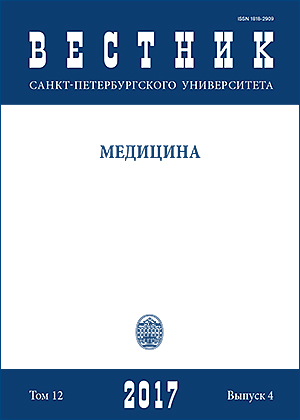THE INTRODUCTION OF LAPAROSCOPY INTO PRACTICE WITH SUBSEQUENT DELAYED OPERATIONAL TREATMENT IN COMPLICATED DIVERTICULAR DISEASE OF THE COLON
DOI:
https://doi.org/10.21638/11701/spbu11.2017.405Abstract
During 5 years from 2011 to 2015, 656 patients with a diverticular disease of a colon were brought to the Aleksandrovsky hospital. From the total number of patients in 504 (76.8%) cases diverticulitis was diagnosed. 124 (24.6%) patients with diverticulitis underwent emergency operations. Primary laparoscopy was executed on 73 (58.9%) patients, and traditional laparotomy was executed on 51 (61.1%). For an assessment of the expediency of primary use of laparoscopy, two equivalent groups of patients were established. The first group included 39 patients who got only traditional emergency surgeries. Second group included 66 patients who received primary laparoscopic treatment. To all patients from the first group obstructive operations that ended with the removal of colostomy, were executed. Primary use of a laparoscopic technique for patients whose had indications for emergency expeditious treatment gave the chance to 40 (60.6%) patients to refuse further expansion of the emergency operational intervention and to finish their operation with laparoscopy alone. To 4 patients (6.1%) laparoscopic assisted colostomy was carried on. Conversion was required only for 22 (33.3%) patients. The research conducted has shown that primary use of laparoscopy allows to lower total postoperative complications by 10.5%, from 43.7% to 33.3% without change in general mortality. Taking into account all the stages of treatment, a decrease by 54.4% of the number of patients with colostomy, from 92.3% to 37.9%, was observed. Refs 10. Tables 12.
Keywords:
diverticulitis, a laparoscopy, surgical treatment, the delayed operations, the operation laparoscopic assisted
Downloads
References
References
Sheen V., Kurzbard N., van Oijen M. G., Yen L., Hodgkins P., Erder M. H., Spiegel B. Long-term risk of acute
diverticulitis among patients with incidental diverticulosis found during colonoscopy. Clin. Gastroenterol.
Hepatol., 2013, no. 11, pp. 1609–1613.
incidental diverticulosis to acute diverticulitis. Gastroenterology, 2012, no. 142 (suppl. 1), p.144.
experience with laparoscopic lavage for perforated diverticulitis. British Journal of Surgery, 2013, vol. 100, no. 5, pp. 704–710.
Downloads
Published
How to Cite
Issue
Section
License
Articles of "Vestnik of Saint Petersburg University. Medicine" are open access distributed under the terms of the License Agreement with Saint Petersburg State University, which permits to the authors unrestricted distribution and self-archiving free of charge.




